Understanding Right Brain vs Left Brain Dynamics
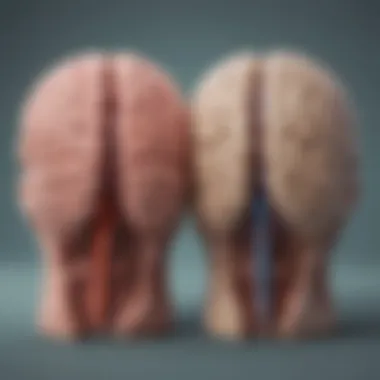
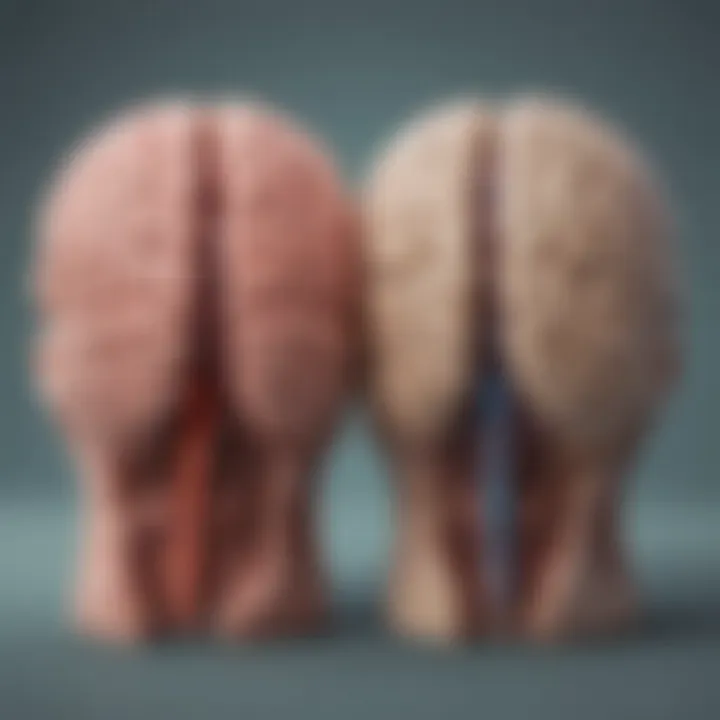
Research Overview
Preface to the topic under study
The exploration of the dichotomy between the left and right hemispheres of the brain is a topic often discussed in both scientific and popular contexts. Historically, this theory posited that the brain's left side was responsible for logical reasoning and analysis, while the right side was linked to creativity and intuition. This simplified viewpoint has led to generalizations about personalities and cognitive styles based on hemispherical dominance. However, recent research calls into question the validity of such binary categorizations and suggests a more integrative approach to understanding how both sides of the brain collaborate in shaping human behavior and cognition.
Summary of existing research findings
Various studies have examined the neurological and psychological implications of hemispheric lateralization. Some findings suggest that while certain functions may indeed be localized predominantly in one hemisphere, the brain operates as a highly interconnected organ. For instance, language processing often occurs in the left hemisphere, yet emotional aspects of communication are managed by the right. This interdependence illustrates that the relationship between the hemispheres is not straightforward. Research has demonstrated that individuals do not necessarily exhibit clear traits of either a "left-brained" or "right-brained" personality. Instead, cognitive and emotional processes are influenced by both sides in a more nuanced manner.
Key research methodology explained
In exploring the left versus right brain theory, researchers employ various methods. Neuroimaging techniques, such as functional magnetic resonance imaging (fMRI) and positron emission tomography (PET), allow scientists to observe brain activity in real-time. Case studies and longitudinal research also contribute valuable insights into how individuals utilize both hemispheres in diverse tasks ranging from artistic expression to logical problem solving. This multifaceted approach provides a more accurate representation of how the brain functions in regards to personality and cognitive processing.
Health Implications
Discussion on the impact of the research on health
Understanding the lateralization of brain function has significant health implications. Comprehension of how both hemispheres contribute to cognitive processes can inform treatment strategies for various psychological conditions, such as anxiety and depression. Additionally, recognizing individual cognitive styles allows for tailored educational approaches, enhancing learning outcomes.
Exploration of potential benefits and risks
The benefits of this knowledge are manifold. For instance, fostering creativity and emotional intelligence may be vital in occupations that demand innovative solutions. However, a risk lies in stigmatizing individuals based on perceived hemispheric dominance. Oversimplifying personalities can lead to misunderstandings and may not accurately reflect an individual’s capabilities.
Examples of how the findings can be applied in daily life
In practical terms, education systems can implement this understanding by designing curricula that engage both hemispheres. Cooperative activities that blend analytical and creative skills can help students develop a more holistic approach to problem-solving.
Well-being Strategies
Practical tips and strategies derived from the research
Integrating strategies to benefit from both hemispheres can enhance overall well-being. Engaging in activities that stimulate creativity—like painting or playing music—can improve emotional health. Similarly, analytical tasks such as puzzles or logical games can sharpen cognitive abilities.
Advice on implementing positive changes for well-being
To apply these insights, individuals can practice balance in their daily routines. Setting aside time for both creative expression and logical reasoning can create a harmonious approach to cognitive function. Track progress and modify activities based on what feels most beneficial.
Personal stories or case studies supporting the strategies
Case studies illustrate that individuals who balance their cognitive styles report increased satisfaction in both personal and professional spheres. For example, an engineer who doodles or sketches during brainstorming sessions often generates more innovative solutions than those who rely solely on conventional methods.
Expert Insights
Analysis of expert opinions on the research findings
Experts in neuroscience advocate for a more sophisticated understanding of brain function. They emphasize that both hemispheres are essential, and the interplay between them is crucial for effective decision-making and creativity. Interdisciplinary studies highlight that skills can often be developed regardless of presumed dominance.
Q&A session with a relevant expert on the topic
A recent interview with Dr. Tasha H. Lawrence, a cognitive neuroscientist, sheds light on these dynamics:
Q: How can we better appreciate the contributions of both brain hemispheres?
A: By recognizing that creativity and logic are intertwined, we can cultivate environments—be it in education or workplaces—that nurture both skills. The key is to move beyond labels.
Links to related articles or studies for further reading
Recommended books, websites, or courses for in-depth learning
- The Whole-Brain Child by Daniel J. Siegel
- Think Like a Programmer for an analytical approach
Tools or apps that can assist in applying the research findings
- Brain training apps like Peak or Lumosity
- Journals for creativity like Mindful Creativity
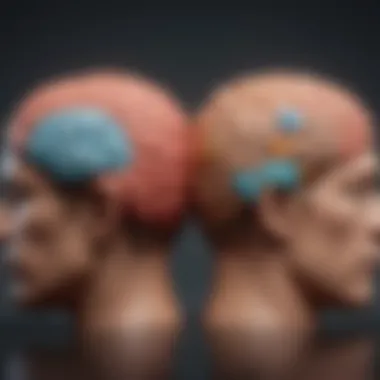
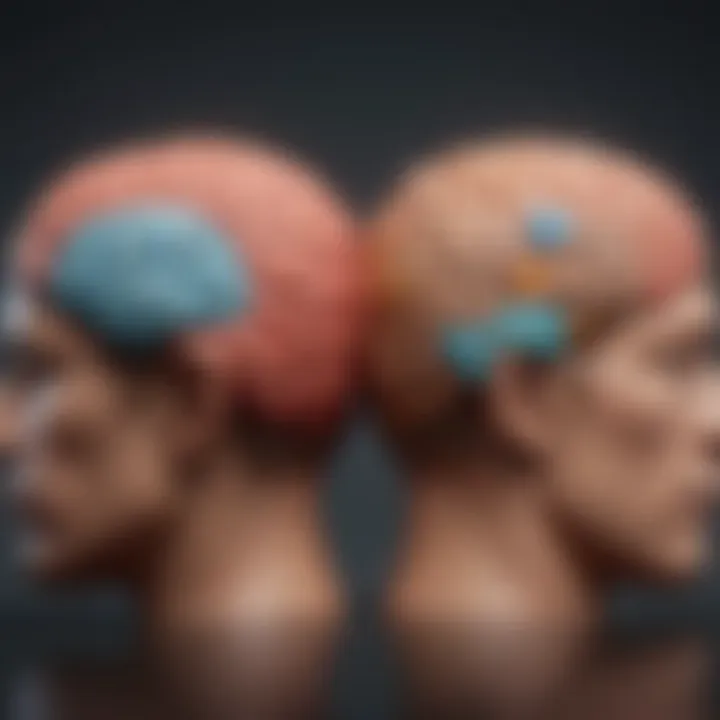
Understanding the dichotomy of the brain is essential, as it opens new pathways to enhance cognitive abilities and emotional well-being.
Prelude to Brain Hemispheres
The study of brain hemispheres has become an essential aspect of understanding human cognition and behavior. Analyzing the interplay between the left and right brains can illuminate how individuals process information, approach problems, and engage with the world around them. Recognizing this dichotomy not only sheds light on neurological processes but also offers insight into diverse cognitive styles and learning preferences.
In this article, we will explore the distinctive functions attributed to each hemisphere. The relevance of understanding brain lateralization affects fields ranging from education and psychology to artificial intelligence. This knowledge can empower individuals to optimize their cognitive skills, improve learning methods, and enhance interpersonal relationships.
Overview of Brain Anatomy
The human brain is a complex structure divided into two hemispheres—left and right. Each hemisphere governs different cognitive functions and processes. The left hemisphere is traditionally associated with analytical tasks, language, and mathematical abilities, while the right hemisphere is linked to creativity, intuition, and holistic thinking.
Neuroimaging studies and anatomical research have shown that these two halves not only carry distinct responsibilities but also communicate extensively through the corpus callosum. This band of neural fibers allows for sharing of information between hemispheres, creating a comprehensive network for cognitive processing. Understanding how these structures operate can inform strategies for learning and personal development.
Historical Context of Brain Lateralization
The concept of brain lateralization has deep roots in scientific inquiry. From early observations in the 19th century to contemporary research, the understanding of how the left and right sides of the brain function differently has evolved significantly.
In the early studies, researchers like Paul Broca identified regions responsible for speech in the left hemisphere, while case studies of patients with brain injuries revealed distinct deficits linked to regions on either side. The field expanded with the advent of neuroimaging techniques that allowed for a more nuanced view of brain function.
However, oversimplifications arose, leading to popularly held beliefs about personality traits being strictly categorized by hemisphere. Challenging these notions has led to critical discourse in the scientific community, revealing that both hemispheres contribute together in most cognitive tasks, creating a more integrated understanding of human behavior and intelligence.
Functions of the Left Hemisphere
The left hemisphere of the brain plays a crucial role in various cognitive functions that are essential for daily life. Understanding these functions helps in appreciating the complexity of human thought and behavior. This section will delve into the specific capabilities of the left hemisphere, focusing on language processing, analytical thinking, and mathematical abilities.
Language Processing
Language processing is one of the most well-known functions of the left hemisphere. It encompasses the ability to understand and produce language, which is fundamental to human communication. Broca's area and Wernicke's area, located in the left hemisphere, are integral to speech production and language comprehension, respectively. Individuals who suffer damage to these areas may experience difficulties in speaking or understanding, known as aphasia.
The efficiency of language processing in the left hemisphere allows for the articulation of complex ideas and emotions. Studies show that people who predominantly use their left hemisphere may excel in verbal tasks and activities that involve reading and writing. This capability extends beyond mere words—successful communication involves understanding context, tone, and nuances, all of which are supported by left-hemispheric functions.
Analytical Thinking
Analytical thinking, another key function of the left hemisphere, involves breaking down complex information into smaller, manageable parts. This skill is essential for problem-solving and decision-making processes. Left-brain thinkers often rely on logic and structured methods, making them adept at evaluating situations methodically.
Analytical thinking enables individuals to approach challenges with a clear framework. They often excel in fields that require critical thinking, such as science and law. The left hemisphere's focus on details and factual accuracy aids significantly when it comes to analyzing data or crafting arguments, further enhancing overall cognitive effectiveness.
Mathematical Abilities
Mathematical ability is closely associated with the left hemisphere of the brain. This includes not only arithmetic skills but also the capacity to engage in abstract mathematical concepts. Individuals with a strong left-brain orientation often report comfort in numerical reasoning and solving equations.
Research has indicated that the left hemisphere processes numerical information more efficiently than the right. This affinity for mathematics encompasses skills like logical reasoning and systematic problem-solving, ultimately contributing to a broader understanding of numerical relationships.
Functions of the Right Hemisphere
The right hemisphere of the brain plays a crucial role in various cognitive functions. It is often associated with creativity and the arts but also contributes significantly to other areas like perception and emotion. Understanding these functions is important because they not only shape individual personality traits but also influence how people engage with the world around them.
The right hemisphere facilitates a blend of skills that can enhance both personal and professional experiences. Appreciating these diverse functions is vital for anyone looking to develop their cognitive abilities. Below, we explore three essential functions of the right hemisphere: creative expression, spatial awareness, and nonverbal communication.
Creative Expression
Creative expression is often viewed as the domain of the right brain. This hemisphere supports the generation of artistic ideas and allows the individual to think beyond conventional boundaries. Various art forms, from painting to music, require this kind of thinking. Creativity is not restricted to artistic activities, however; it encompasses problem-solving in unconventional ways.
For example, many innovators and thinkers rely on their ability to draw connections between seemingly unrelated concepts. Studies indicate that individuals with a strong right-brain orientation may often exhibit heightened imagination and originality.
"The right hemisphere's preference for holistic processing enables a broader perspective essential for innovative thinking."
Fostering creativity involves not just practice in artistic endeavors but also embracing a mindset open to new experiences. Engaging in activities such as brainstorming sessions or creative workshops can significantly enhance one's creative capabilities.
Spatial Awareness
Spatial awareness is another key function linked to the right hemisphere. This ability refers to how we perceive, remember, and manipulate the spatial relationships between objects. People with strong spatial skills often excel in fields like architecture, engineering, and design. The right hemisphere's prowess in managing spatial tasks enables a person to visualize three-dimensional relationships, which is important for navigation and understanding physical spaces.
Research shows that spatial awareness is integral to scientific and mathematical abilities too. These skills are not limited to professional tasks; they can improve daily life through better navigation, organization, and planning.
Methods to develop spatial awareness include puzzles, model-building, or even engaging in video games that emphasize spatial reasoning. Pursuing these activities contributes to an enhanced understanding of one’s physical environment.
Nonverbal Communication

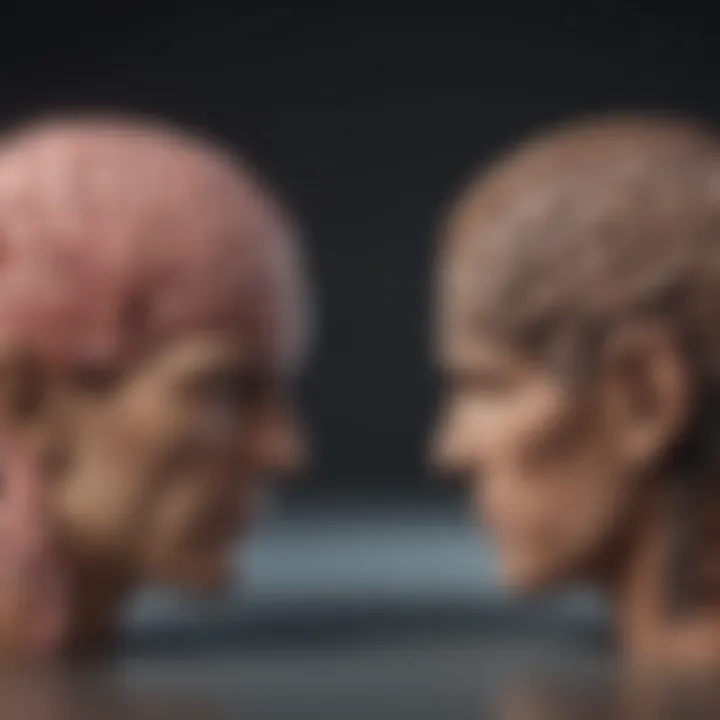
The right hemisphere is fundamental in nonverbal communication. This includes the interpretation of body language, facial expressions, and tone of voice. Unlike the left hemisphere, which handles verbal communication, the right side processes emotional and contextual cues that inform interpersonal relationships.
Understanding nonverbal signals can lead to more effective communication and stronger connections with others. It enhances the ability to empathize, allowing individuals to gauge the emotions of those around them without depending solely on spoken words. This competency has significant implications for social interactions, therapy, and counseling.
Improving nonverbal communication skills can involve practicing active listening, engaging in role-play scenarios, and paying attention to the nonverbal cues in various social contexts. Mastering this skill can substantially enrich personal and professional relationships.
By understanding the diverse functions of the right hemisphere, individuals can harness their potential in creative expression, spatial reasoning, and nonverbal communication. This knowledge empowers a more nuanced view of cognitive processes, fostering personal and professional growth.
The Myth of the Left-Brain vs. Right-Brain Personality
The discussion around left-brain and right-brain functions has created a broad interest in personality traits connected to these hemispheres. Many people wish to categorize themselves based on these perceived characteristics. This section explores how this myth developed and why it holds relevance today. The idea that individuals can be strictly categorized as either left-brain or right-brain thinkers is overly simplistic. Human cognition is complex, and reducing personality to this framework can lead to misunderstandings and misrepresentations.
Origins of the Concept
The notion of left-brain and right-brain dominance originates from early research in neuropsychology in the 1960s. Researchers such as Roger Sperry demonstrated differences in functions of the two sides of the brain through studies involving patients who underwent hemispherectomies. Sperry's work suggested that the left hemisphere is primarily responsible for language and analytical tasks, while the right hemisphere is associated with creativity and intuition.
As these ideas gained traction, popular culture began to exaggerate them. Books, articles, and online discussions popularized the concept that people could be classified as left-brained, favoring logic, or right-brained, valuing creativity.
Scientific Critiques
While the left-brain versus right-brain theory has some grounding in science, it is essential to approach it with caution. Neuroscience has complicated this binary view significantly. Several key points need attention:
- Holistic Functionality: Both hemispheres communicate extensively through the corpus callosum. Most cognitive tasks require input from both sides, meaning personality cannot be solely attributed to one hemisphere.
- Continuum Rather than Dichotomy: Research indicates that attributing strict left or right dominance oversimplifies the nuanced interplay between various cognitive processes.
- Individual Variability: Factors such as environment, education, and personal experiences shape thinking styles, making them unique to each individual.
Current scientific understanding suggests that the brain operates as a cohesive unit rather than a dichotomy.
This critique reflects the importance of acknowledging the complexity of human behavior and cognition. Misrepresenting individuals as strictly left or right-brained may hinder self-understanding and limit personal growth. Awareness of these facts may foster a more inclusive view of cognitive abilities, reframing our understanding of personality as a spectrum influenced by a wide range of factors.
Brain Plasticity and Lateralization
Brain plasticity, often called neuroplasticity, refers to the brain's ability to adapt and reorganize itself in response to experiences. This flexibility is crucial for learning, recovery from injuries, and the ongoing development of cognitive skills. Lateralization refers to how various brain functions are distributed between the two hemispheres. Understanding the link between plasticity and lateralization is important as it highlights how both hemispheres can compensate for each other, particularly in the face of challenges.
Neuroplasticity implies that the brain is not fixed but rather malleable. This reinforces the idea that skills can be cultivated over time, allowing individuals to enhance their cognitive functions, regardless of age. For instance, if one hemisphere is damaged, the other may take over functions that were previously localized. This is particularly essential for major life events, such as stroke recovery.
Furthermore, engaging in tasks that stimulate both hemispheres can foster not only balance but also creativity and problem-solving skills. Thus, neuroplasticity plays a pivotal role in understanding how functions associated with the left and right hemispheres might shift in affected individuals or those predisposed to specific cognitive styles.
Understanding Neuroplasticity
Neuroplasticity encompasses several elements that contribute to cognitive development and recovery.
- Synaptic Plasticity: The ability of synapses to strengthen or weaken over time, based on activity levels.
- Functional Recovery: Brain regions can take over functions if another area is damaged. This process showcases the adaptability inherent in brain structure.
- Experience-Dependent Plasticity: Learning new skills or information leads to structural changes in the brain. For example, studying a musical instrument or engaging in a new language can physically alter neural connections.
These aspects illustrate that neuroplasticity is not just about structure but also involves cognitive processes. Each time a new learning occurs, it forms a unique neural pathway. Consequently, fostering environments rich in diverse stimuli can significantly enhance cognitive performance across genders and ages.
Impact on Cognitive Skills
The influence of brain plasticity on cognitive skills is profound. It allows individuals to:
- Adapt to New Information: Faster learning and integration of new concepts.
- Recover from Brain Injuries: Enhances potential for regaining lost skills, such as language or movement.
- Develop Unique Problem-Solving Approaches: Each brain, with its specific lateralization characteristics, finds diverse ways to tackle challenges.
Ultimately, understanding the intersection of brain plasticity and lateralization leads to better educational strategies and therapies. Facilitating activities that engage both hemispheres supports a balanced cognitive approach and promotes mental wellness.
"The brain is capable of recognizing and adapting to its own functional limitations, a true hallmark of neuroplasticity that can transform lives."
Implications for Learning and Education
The interactions between the left and right hemispheres of the brain offer significant insights for learning and education. Understanding these implications can guide educators in creating more effective teaching strategies. Focusing on the distinct ways in which each hemisphere operates can enhance curricular development and inform methods for skill acquisition. Taking a holistic approach in education is essential, as it accommodates diverse learning needs and promotes better cognitive outcomes.
Diverse Learning Styles
Cognitive styles differ based on whether students lean towards left-brain or right-brain functions. Left-brained learners often excel with structured learning methods. They favor logical reasoning, sequential processing, and factual information. This group thrives in environments where they can engage in analysis, problem-solving, and organization of information.
Right-brained learners, in contrast, often prefer a more open-ended learning environment. They tend to be intuitive and imaginative, appreciating methods that incorporate visuals, creativity, and holistic thinking. These students may favor projects over tests, where they can express ideas freely. Understanding these variations allows educators to tailor their approaches to suit different learners.
- Encourage collaboration among students with varying cognitive styles.
- Use a mix of teaching tools like visuals, discussions, and hands-on activities.
- Assess learners through various formats, including portfolios and presentations.
Incorporating Hemisphere Functions in Curriculum
Incorporating the functions of both hemispheres in the curriculum leads to a balanced educational experience. An integrated approach effectively cultivates both analytical and creative skills. For instance, using storytelling in a science class can enhance understanding. This technique connects students emotionally and intellectually, bridging the gap between factual knowledge and creative expression.
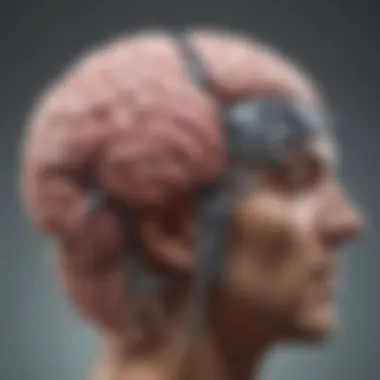
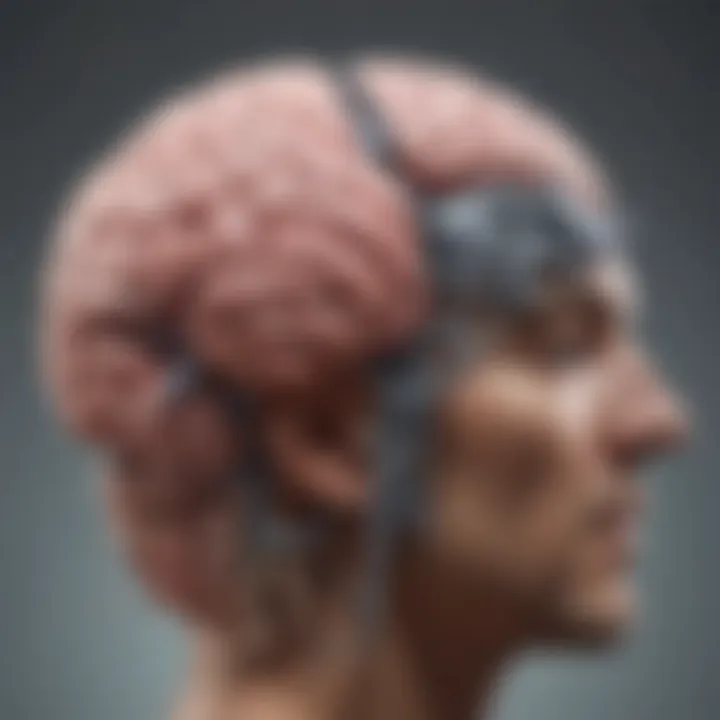
Educators should consider specific techniques:
- Project-based learning: This method engages both hemispheres, tapping into creativity while addressing logical tasks.
- Dual-coded instruction: Presenting information through verbal and visual formats benefits diverse learners by capitalizing on the unique strengths of each hemisphere.
- Flexible assessments: Implementing options like traditional tests, creative projects, or presentations accommodates different learning styles and preferences.
"Recognizing the individual learning styles of students helps in creating a nurturing educational environment."
Supporting both hemispheres' functions fosters a more inclusive classroom. Teachers who are aware of these dynamics can adapt their pedagogical techniques. This commitment to understanding cognitive processes ultimately has the potential to improve student engagement, retention, and overall academic performance.
Cognitive Balance and Well-Being
Cognitive balance is essential for overall well-being. It refers to the harmonious functioning of both brain hemispheres, allowing individuals to leverage their full cognitive potential. A person who achieves cognitive balance can draw from both analytical and creative strengths. This duality helps in various aspects, such as problem-solving, decision-making, and emotional regulation. It has significant implications for personal development and emotional health.
The benefits of maintaining cognitive balance include improved adaptability and resilience. Individuals who develop strengths in both hemispheres can respond more effectively to challenges. They can analyze situations critically while also thinking creatively. This approach fosters a well-rounded perspective, enhancing not only cognitive skills but also interpersonal relationships.
Concept of Cognitive Balance
Cognitive balance is rooted in the idea that both sides of the brain contribute uniquely to our thoughts and perceptions. The left hemisphere is often associated with logic, language, and analytical tasks. In contrast, the right hemisphere is linked to intuition, creativity, and holistic thinking. The interplay between these two sides is vital.
For instance, a balanced individual might employ logical reasoning to identify a problem and use creativity to generate innovative solutions. This integration leads to effective problem-solving strategies and better decision-making. Moreover, research suggests that fostering cognitive balance can enhance emotional intelligence, which is crucial for personal and professional success.
Adapting your mindset to embrace both left and right-brain functions can lead to a more fulfilling life. Recognizing when to engage each hemisphere can prevent cognitive over-reliance on one way of thinking, which is common in many educational and work environments.
Strategies for Enhancing Cognitive Skills
Enhancing cognitive skills involves intentional activities that stimulate both hemispheres of the brain. Here are some effective strategies:
- Engage in Diverse Learning: Explore subjects outside your comfort zone. Creative writing can stimulate the right hemisphere, while studying mathematics can engage the left.
- Practice Mindfulness and Meditation: These practices promote emotional balance and reduce stress, enabling both hemispheres to function cohesively.
- Incorporate Physical Activity: Activities such as dance or martial arts can enhance coordination and engage both sides of the brain.
- Play Strategy Games: Games like chess or Sudoku encourage analytical thinking. They can be complemented with artistic activities such as painting or music.
- Limit Multitasking: Focus on one task at a time. This allows deeper engagement with either side of the brain while ensuring a balanced approach over time.
By integrating these strategies into daily routines, individuals can cultivate a more balanced cognitive profile. This balance is not just an academic exercise; it has real-world applications in areas like creative problem-solving in the workplace or enhancing interpersonal relations.
"Cognitive balance is not merely an ideal state; it is a practical framework for fostering personal growth and well-being."
Investing time in understanding and enhancing cognitive balance can yield substantial benefits. It can transform how individuals navigate challenges, interact with others, and ultimately, lead meaningful lives. By embracing this concept, individuals can work toward a state of well-being that promotes success in both personal and professional arenas.
Real-World Applications
The exploration of brain lateralization has immense implications across various domains. Understanding how the left and right hemispheres contribute distinctively to cognition enables professionals to tailor approaches in education, therapy, and workplace dynamics. Recognizing these differences can enhance decision-making processes, boost creativity, and improve interpersonal relationships.
Impacts on Professional Environments
In today’s diverse professional landscape, understanding the dichotomy between left and right brain functions can provide a competitive edge. For instance, left-brained skills—such as analytical thinking and problem-solving—are essential in fields like finance, engineering, and law. Employees who excel in these areas can dissect complex issues and make data-driven decisions.
Conversely, the creative prowess associated with the right hemisphere proves invaluable in fields like marketing, design, and the arts. Professionals here benefit from innovative thinking and the ability to visualize concepts. The challenge often lies in fostering a synergistic environment where both skill sets interact effectively.
Organizations can implement training that encourages cross-functional collaboration. Teams composed of individuals who harness both hemispherical powers can tackle projects with greater creativity and precision. Notably, accommodating diverse cognitive styles may even improve overall job satisfaction and retention.
The Role in Therapy and Counseling
The role of brain lateralization extends into therapeutic practices as well. Understanding a client's cognitive style can inform treatment methods, ultimately enhancing communication and outcomes. For example, clients who lean towards right-brain processing might benefit from expressive therapies, such as art or music, tapping into their creative reservoirs.
Therapists specializing in cognitive behavioral therapy can also leverage insights from laterality theories. Recognizing that left-brained clients may appreciate structured, logical approaches can guide the development of personalized treatment plans.
"Tailored interventions based on cognitive differentiation can lead to more effective therapeutic relationships."
Moreover, integrating techniques that stimulate both hemispheres can yield holistic growth in clients. This might include combining logic-based exercises with creative ones, catering to a wider range of individuals. Understanding the complexities of how the brain operates allows therapists to foster deeper connections, ultimately promoting greater mental health and well-being.
By elucidating the real-world applications of brain lateralization, individuals and organizations alike can optimize their functions, collaboratively enhancing both professional and therapeutic realms.
End and Future Directions
As we draw this exploration to a close, it is crucial to underscore the significance of brain lateralization and its implications for our understanding of human cognition. The discourse surrounding the left and right hemispheres offers more than academic curiosity; it invites us to reconsider how we comprehend thinking, creativity, and decision-making.
Revisiting Brain Lateralization Theory
The theory of brain lateralization, which posits that certain cognitive functions are localized to one hemisphere or another, has been influential in various fields, from education to psychology. Revisiting this theory involves scrutinizing its foundational principles and acknowledging its limitations. Modern neuroscience employs imaging techniques like fMRI and PET scans, revealing a more intricate picture of how the brain operates. Rather than strictly separate functions, many cognitive processes engage networks spanning both hemispheres.
In education, this nuanced comprehension invites tailored approaches to learning. For instance, recognizing that students may leverage strengths in either hemisphere can guide educators in developing diverse teaching methods. Such considerations not only improve learning outcomes but also foster a more inclusive educational environment.
Ongoing Research and Discoveries
The landscape of brain research is continually evolving. Researchers are actively studying the dynamic interplay between the left and right hemispheres, with discoveries that challenge previous assumptions. Now, studies indicate that brain plasticity allows for adaptability in function; even in adulthood, the brain can reorganize itself in response to experiences or injuries.
This adaptability has profound implications. For example, in therapy settings, understanding how different approaches resonate with individuals can optimize treatment plans. By knowing whether a person tends to process information differently, therapists can tailor their methods accordingly.
Moreover, ongoing research into cognitive neuroscience promises to unlock additional insights into the left and right brain functions, enhancing our grasp of creativity, emotional intelligence, and social behaviors. As investigations unfold, they generate valuable information that could inform strategies to optimize mental health and personal development.



